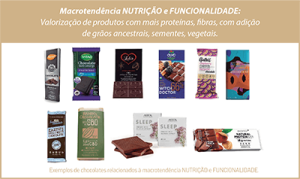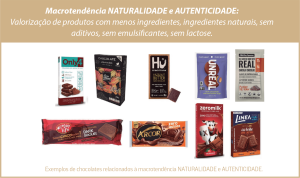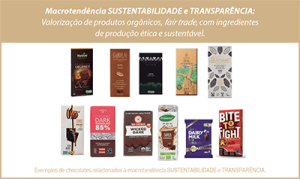CONSUMPTION TRENDS OF INDUSTRIALIZED CHOCOLATES
In their different forms, the products are widely consumed in Brazil. Chocolate bars, chocolate candies and confectionery based on chocolate or cocoa, are available in the market at bakeries, confectioneries and chocolatiers, supermarkets and convenience stores, in addition to being supplied from a large number of artisanal manufacturers that manufacture industrial bars and produce chocolate candies, truffles, homemade Easter eggs as a source of income. Industrial production is responsible for most part of ready-to eat processed chocolates, as well as for the raw materials, such as toppings, powder, nibs, cocoa liquor, whole almonds or in nibs (pieces), among other modalities that are used to make confectionery products and a wide quantity of recipes prepared inside and outside homes.
According to the study Brasil Bakery & Confectionery Trends 2020 (www.bakeryconfectionerytrends.com.br), in Brazil, the chocolates industry is quite developed and markets suitable products to the consumer’s market trend. This study identified five consumption macrotrends that explain well the behavior of the industrialized chocolate demand: Premium Products and Experience, Nutrition and Functionality, Control and Adequacy, Naturalness and Authenticity and Sustainability and Transparency.
PREMIUM PRODUCTS and EXPERIENCE
 The PREMIUM PRODUCTS and EXPERIENCE macrotrend determines the market growth for products with enhanced quality and the appeal for sensory ability, among them there are those with claims for premium and gourmet quality, and also products with appeal to the conscious comfort food, that is, with the previous characteristics, but also more nutritive, with less calories and with natural and sustainable ingredients, that is, with more attributes than the other macrotrends of the sector.
The PREMIUM PRODUCTS and EXPERIENCE macrotrend determines the market growth for products with enhanced quality and the appeal for sensory ability, among them there are those with claims for premium and gourmet quality, and also products with appeal to the conscious comfort food, that is, with the previous characteristics, but also more nutritive, with less calories and with natural and sustainable ingredients, that is, with more attributes than the other macrotrends of the sector.
In the United States, the increasing demand for artisanal chocolates has been strong in the latest years, which can be also verified in Brazil.
Consumers are also identifying the value of chocolates based on manufacturing processes, described in the packages, which highlight the greater care in the products preparation.
A global research from Puratos observed that the flavor constituted the most important factor in the decisions to buy chocolates.
NUTRITION and FUNCTIONALITY
 Traditionally concentrated in products with differentiated textures, colors, and flavors, the demand for chocolates has also been focused on products with more nutritive and functional ingredients, which is comprised in the NUTRITION and FUNCTIONALITY macrotrend. A study conducted by Barry Callebaut verified that 44% of the chocolate bars consumers consider the content of proteins in the product as important. In Latin America, another research conducted by Barry Callebaut identified that 53% of consumers considered chocolates with functional and medicinal claims healthier, while 51% believe that the plant-based or vegan chocolates are the healthiest.
Traditionally concentrated in products with differentiated textures, colors, and flavors, the demand for chocolates has also been focused on products with more nutritive and functional ingredients, which is comprised in the NUTRITION and FUNCTIONALITY macrotrend. A study conducted by Barry Callebaut verified that 44% of the chocolate bars consumers consider the content of proteins in the product as important. In Latin America, another research conducted by Barry Callebaut identified that 53% of consumers considered chocolates with functional and medicinal claims healthier, while 51% believe that the plant-based or vegan chocolates are the healthiest.
Consumption of chocolates with more protein is also mentioned in a study conducted by Cargill, and highlights the addition of fruits and vegetables as a resource to increase the chocolates functional properties.
The content of cocoa is highlighted as the most import in the chocolate health identification, it was verified by the global research conducted by Puratos.
CONTROL and ADEQUACY
 In addition to the higher interest on the suitable nutrients intake, the CONTROL and ADEQUACY macrotrend is characterized by the concern that many consumers are trying to balance their dally meals, seeking to control the consumption of food with high content of salt, fats, calories, and even gluten.
In addition to the higher interest on the suitable nutrients intake, the CONTROL and ADEQUACY macrotrend is characterized by the concern that many consumers are trying to balance their dally meals, seeking to control the consumption of food with high content of salt, fats, calories, and even gluten.
Puratos’s research highlights that the perception by consumers of health chocolates is not related only to addition of nutritive and functional ingredients, but also by the reduction of ingredients they consider undesirable, such as, for example, sugar. Cargill’s report highlights that the popularity of the claim “sugar-free” have increased in many categories of products, and esteviol glycosides use has been an potion to prepare chocolates with these characteristics.
In Latin America Barry Callebaut research identified that “39% of consumers look for chocolates with reduced or low calories, and 37% look for chocolates with little sugar”.
NATURALNESS and AUTHENTICITY
 Associated to the consumers preference for comfort food and health, the NATURALNESS and AUTHENTICITY macrotrend signalizes to the valuation of products with less ingredients, realized as artisanal and natural.
Associated to the consumers preference for comfort food and health, the NATURALNESS and AUTHENTICITY macrotrend signalizes to the valuation of products with less ingredients, realized as artisanal and natural.
Studies conducted by Barry Callebaut identified that more than 60% young consumers (millennial generation) consider that clean label chocolates, that is, simpler, natural products and with less ingredients, are more authentic and real.
In addition, a Cargill’s report observed that consumers are valuing ingredients with more familiar names. The clean label concept also comprises “free from” milky ingredients, gluten, soybean, among other hat have been avoid by consumer, due to varied reasons.
The use of aromas and sweeteners considered as more natural have been more common in launching chocolates with claims related to naturalness.
SUSTAINABILITY and TRANSPARENCY
 The SUSTAINABILITY and TRANSPARENCY macrotrend represents the valuation of the way industrialized food is made and also the importance attributed to the manufacturers social and environmental responsibility.
The SUSTAINABILITY and TRANSPARENCY macrotrend represents the valuation of the way industrialized food is made and also the importance attributed to the manufacturers social and environmental responsibility.
The conscious consumption has been increasing and consumers are valuing the sustainable production practices and refusing chocolates with ingredients such as palm oil. According to Cargill’s report, the interest in the food origin is increasing, how they are produced from the ethical and environmental point of view, and the valuation of chocolates prepared with cocoa from sustainable and traceable origin is occurring.
It is observed the increase of demand for organic products, fair trade, with environmental certificates, such as UTZ and Rainforest Alliance.
According to the Puratos’ study, globally, more than half of the consumers recognize the importance of food from producers fairly paid.




